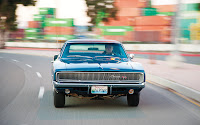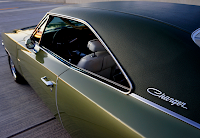The Dodge Charger produced by Chrysler from 1966–1978 was built on the Chrysler B platform.
In 1968, the entire B-body lineup was redesigned with a double-diamond coke bottle profile
with curves around the front fenders and rear quarter panels.
The rear end featured a "kick up" spoiler appearance, inspired by Group 7 racing vehicles.
On the roof, a "flying buttress" was added to give the rear window area.
The Charger retained its full-width hidden headlight grille, but the fully rotating electric
headlights in '66-'67 models had been replaced by a simple vacuum operated cover.
The full-width taillights were also replaced by dual circular taillights.
Basic engine was the 225 cu in (3.7 L) 1bbl I6.
A new high-performance package, the R/T (or pronounced "Road Track")
came standard with the previous year's 440 "Magnum" and the 426 Hemi was optional.
In 1968, Chrysler Corporation unveiled a new ad campaign featuring a Bee with an engine on its back.
These cars were called the "Scat Pack".
The Coronet R/T, Super Bee, Dart GTSand Charger R/T received
optional bumble-bee stripes (two thin stripes framing two thick stripes).
(wikipedia)
(Photos from motortrend.com, commons.wikimedia.org,
popularhotrodding.com & conceptcarz.com)
The famous car chase in the 1968 movie Bulitte
between a 1968 390 V8 Ford Mustang GT fastbacks and
a 1968 375 hp 440 Magnum V8-powered Dodge Charger R/T.


between a 1968 390 V8 Ford Mustang GT fastbacks and
a 1968 375 hp 440 Magnum V8-powered Dodge Charger R/T.


























































